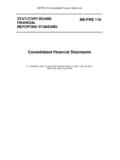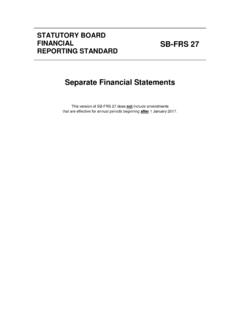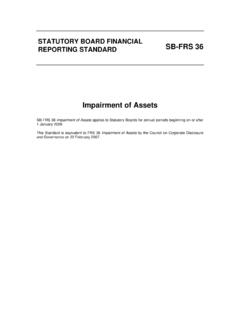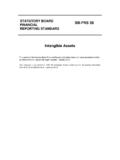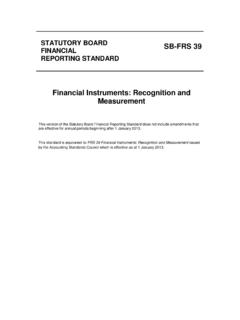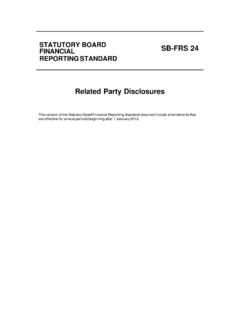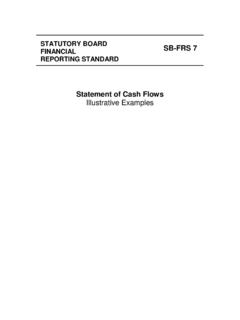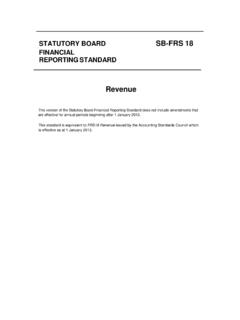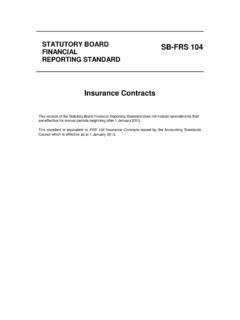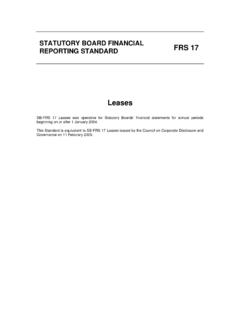Transcription of The Effects of Changes in Foreign Exchange Rates - …
1 STATUTORY BOARD FINANCIAL SB-FRS 21 REPORTING STANDARD The Effects of Changes in Foreign Exchange Rates SB-FRS 21 The Effects of Changes in Foreign Exchange Rates was operative for Statutory Boards financial statements covering periods beginning on or after 1 January 2004. This Standard is equivalent to FRS 21 The Effects of Changes in Foreign Exchange Rates issued by the Council on Corporate Disclosure and Governance on 11 Feburary 2005. 1 Contents Paragraphs Statutory Board Financial Reporting Standard 21 The Effects of Changes in Foreign Exchange Rates OBJECTIVE 1-2 SCOPE 3-7 DEFINITIONS 8-16 Elaboration on the Definitions 9-16 Functional Currency 9-14 Net Investment in a Foreign Operations 15 Monetary Items 16 SUMMARY OF THE APPROACH REQUIRED BY THIS STANDARD 17-19 REPORTING Foreign CURRENCY TRANSACTIONS IN THE FUNCTIONAL CURRENCY 20-37 Initial Recognition 20-22 Reporting at
2 Subsequent Balance Sheet Dates 23-26 Recognition of Exchange Differences 27-34 change in Functional Currency 35-37 USE OF A PRESENTATION CURRENCY OTHER THAN THE FUNCTIONAL CURRENCY 38-49 Translation to the Presentation Currency 38-43 Translation of a Foreign Operation 44-47 Disposal of a Foreign Operation 48-49 TAX Effects OF ALL Exchange DIFFERENCES 50 DISCLOSURE 51-57 EFFECTIVE DATE AND TRANSITION 58-60 2 Statutory Board Financial Reporting Standard 21 The Effects of Changes in Foreign Exchange Rates (SB-FRS 21) is set out in paragraphs 1-62 and the Appendix.
3 All the paragraphs have equal authority. SB-FRS 21 should be read in the context of its objective, the Preface to Statutory Board Financial Reporting Standards and the Framework for the Preparation and Presentation of Financial Statements. SB-FRS 8 Accounting Policies, Changes in Accounting Estimates and Errors provides a basis for selecting and applying accounting policies in the absence of explicit guidance. 3 STATUTORY BOARDS FINANCIAL REPORTING STANDARD SB-FRS 21
4 The Effects of Changes in Foreign Exchange Rates Objective 1. An entity may carry on Foreign activities in two ways. It may have transactions in Foreign currencies or it may have Foreign operations. In addition, an entity may present its financial statements in a Foreign currency. The objective of this Standard is to prescribe how to include Foreign currency transactions and Foreign operations in the financial statements of an entity and how to translate financial statements into a presentation currency. 2. The principal issues are which Exchange rate(s) to use and how to report the Effects of Changes in Exchange Rates in the financial statements.
5 Scope 3. This Standard shall be applied: * (a) in accounting for transactions and balances in Foreign currencies, except for those derivative transactions and balances that are within the scope of SB-FRS 39 Financial Instruments: Recognition and Measurement; (b) in translating the results and financial position of Foreign operations that are included in the financial statements of the entity by consolidation, proportionate consolidation or the equity method; and (c) in translating an entity s results and financial position into a presentation currency. 4. SB-FRS 39 applies to many Foreign currency derivatives and, accordingly, these are excluded from the scope of this Standard.
6 However, those Foreign currency derivatives that are not within the scope of SB-FRS 39 ( some Foreign currency derivatives that are embedded in other contracts) are within the scope of this Standard. In addition, this Standard applies when an entity translates amounts relating to derivatives from its functional currency to its presentation currency. 5. This Standard does not apply to hedge accounting for Foreign currency items, including the hedging of a net investment in a Foreign operation. SB-FRS 39 applies to hedge accounting. 6. This Standard applies to the presentation of an entity s financial statements in a Foreign currency and sets out requirements for the resulting financial statements to be described as complying with Statutory Board Financial Reporting Standards.
7 For translations of financial information into a Foreign currency that do not meet these requirements, this Standard specifies information to be disclosed. 7. This Standard does not apply to the presentation in a cash flow statement of cash flows arising from transactions in a Foreign currency, or to the translation of cash flows of a Foreign operation (see SB-FRS 7 Cash Flow Statements). Definitions 8. The following terms are used in this Standard with the meanings specified: * See also INT SB-FRS 7 Introduction of the Euro. 4 Closing rate is the spot Exchange rate at the balance sheet date.
8 Exchange difference is the difference resulting from translating a given number of units of one currency into another currency at different Exchange Rates . Exchange rate is the ratio of Exchange for two currencies. Fair value is the amount for which an asset could be exchanged, or a liability settled, between knowledgeable, willing parties in an arm s length transaction. Foreign currency is a currency other than the functional currency of the entity. Foreign operation is an entity that is a subsidiary, associate, joint venture or branch of a reporting entity, the activities of which are based or conducted in a country or currency other than those of the reporting entity.
9 Functional currency is the currency of the primary economic environment in which the entity operates. A group is a parent and all its subsidiaries. Monetary items are units of currency held and assets and liabilities to be received or paid in a fixed or determinable number of units of currency. Net investment in a Foreign operation is the amount of the reporting entity s interest in the net assets of that operation. Presentation currency is the currency in which the financial statements are presented. Spot Exchange rate is the Exchange rate for immediate delivery. Elaboration on the Definitions Functional Currency 9. The primary economic environment in which an entity operates is normally the one in which it primarily generates and expends cash.
10 An entity considers the following factors in determining its functional currency: (a) the currency: (i) that mainly influences sales prices for goods and services (this will often be the currency in which sales prices for its goods and services are denominated and settled); and (ii) of the country whose competitive forces and regulations mainly determine the sales prices of its goods and services. (b) the currency that mainly influences labour, material and other costs of providing goods or services (this will often be the currency in which such costs are denominated and settled).
